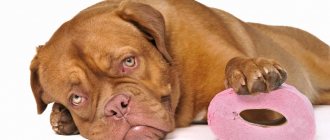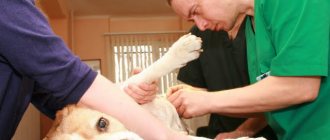Etiology of the phenomenon
The most common reasons:
- Entry of a foreign object;
- Neck injuries (for example, when using a collar that is too narrow);
- Heart diseases.
If a dog swallows a toy or chokes on leftover food, these objects clog the airways. As a result, this leads to the development of an inflammatory process, which is often accompanied by the appearance of sputum.
Some animals have an abnormal structure of the respiratory system from birth. The most striking example is the collapse of the trachea experienced by owners of small breeds. In pathology, the cough is grunting, resulting from the accumulation of air and fluid in the pleural cavity.
Take the Attention Test! Find 10 differences! (click right here!)
Find the answer Are you bothered by some problem or question? Enter “Breed” or “Name of the problem” into the form, press Enter and you will find out everything about the issue that interests you.
A dangerous cause of coughing and vomiting will be pneumonia or adenovirus, the latter disease is transmitted by airborne droplets from an infected individual. Cough is caused by viral diseases, for example, tracheobronchitis (“enclosure” cough). A banal infection of the body with worms causes coughing in dogs.
More often, the dog copes with illnesses on its own, but with a weakened immune system, it will not be possible to recover on its own. If shortness of breath, loss of appetite, or lethargy occurs, contact a veterinarian.
Physiological vomiting
Vomiting once may be a natural process that does not cause concern. The reasons are various:
- An animal deliberately induces vomiting in order to get rid of overeating or a foreign body that has entered the stomach;
- Due to the anatomical structure of the muzzle and mouth, some dog breeds (bulldogs, boxers, mastiffs) constantly salivate. It foams due to active movement of the jaws and connection with air;
- Small breeds of dogs (Yorkshire terrier, etc.) have sensitive digestion. When introducing a new product into the diet or changing the diet, foamy vomiting may occur;
- White foam vomiting may occur after a long period of time between feedings. The stomach constantly produces acid for digestion. If the dog has not eaten for a long time, then gastric juice, mucus and air react, releasing in the form of white foam;
- Foamy discharge can be provoked by stress, fear, motion sickness when moving in transport.
Causes of mucus, foam or drool
Coughing in dogs is accompanied by other unpleasant symptoms - the appearance of foam and mucus, which may indicate congenital anomalies or the development of viral or bacterial diseases.
Kennel cough
A cough is usually accompanied by the appearance of foam, which the dog regurgitates. It develops as a result of a viral infection, in difficult situations it is supplemented by a bacterial complication.
The first sign is the pet's heavy breathing, accompanied by a dry, prolonged cough. In the absence of therapy, vomiting appears, resembling white foam.
Pet owners of any age encounter this disease, but it usually affects young dogs under 2 years of age. The disease is transmitted by airborne droplets, so you can become infected anywhere through contact with a sick dog. The dog owner himself becomes the causative agent, bringing infectious agents from the street on clothes or shoes.
Therapy for this disease is complex and lengthy. This is due to the fact that viruses are constantly changing and mutating.
Pathology is usually caused by groups of viruses - reovirus and adenovirus. Often the disease is complicated by the addition of bacteria. Only a doctor can prescribe treatment based on test results and diagnosis. Self-medication is dangerous - the owner’s wrong actions will harm the pet.
In puppies, pregnant and lactating
Most diseases occur in dogs with weakened immune systems. Puppies, pregnant bitches or dogs nursing offspring are at risk.
Proper care of your pet, proper nutrition, and the use of immunomodulators (medicines can only be prescribed by a veterinarian) will help avoid this problem.
Features of breeds
Every breed has breed-specific diseases. For example, the Cavalier King Charles Spaniel is prone to heart disease. Spitz, Pekingese, and Chihuahuas are often diagnosed with tracheal collapse. The main symptom of these pathologies is cough.
Common causes of vomiting with white foam
If the owner of a pet that has vomited is attentive to it and after the first time there is a second, third, and so on, and the pet’s behavior itself has also changed, then it means that the basis of vomiting is not a physiological feature of the body, but a disease.
This means that putting off going to the vet is jeopardizing the health and life of your pet. Repeated vomiting and changes in the animal’s behavior can be a consequence of the following diseases:
Worms
A dog vomiting white foam may be a consequence of the appearance of worms in the animal. In this case, there is no change in appetite, but the dog begins to rapidly lose weight.
Poisoning
Poisoning with poor quality food or chemicals also causes vomiting with white foam. The consequences of poisoning also include loss of appetite, weakness and lethargy of the pet, and changes in stool. In advanced situations, the animal develops convulsions.
Epilepsy
Epilepsy and its attacks may also be accompanied by a discharge mixed with mucus and white foam. During attacks, the animal’s body begins to reflexively remove the contents of the stomach, possibly uncontrolled urination and a change in awareness of orientation in space.
Labradors, spaniels and Dalmatians most often face this situation.
Plague
The plague form can only affect the intestines. With this infectious disease, redness of the whites of the eyes, photosensitivity are observed, the pet begins to hide from light in dark places, and refuses to eat.
In addition, the dog’s general condition worsens due to diarrhea, stool disorders, fever, and increased temperature (up to 41 degrees). After all the signs that have been listed, the dog quickly becomes completely exhausted.
Rabies
White viscous foam coming out of a dog's mouth is a sign of a dangerous, fatal disease. Uncontrolled and increased salivation is complemented by aggressive behavior and fear of water.
In this case, doctors may observe insufficiency of the respiratory organs and paralysis of the pharynx of the lower jaw. The pet cannot swallow food, and it is also established that the dog can eat inedible objects.
Rabies cannot be cured if a dog is already infected, so it is extremely important to take it to a clinic, isolate it and euthanize it before it bites its owner or other animals.
Digestive system diseases
If the owner notices initial vomiting with white foam, and subsequent discharge changes in color and condition, then this may be a sign of diseases associated with the digestive tract:
- hepatitis;
- ulcer;
- malignant formations;
- cholecystitis.
What to do during attacks
If the animal begins to choke, call a veterinarian immediately. While the specialist is on his way, they help their pet. First, the pharynx is examined for the presence of a foreign body. If a piece of food or a small toy is not stuck too deep, try to pull it out with tweezers, holding the pet tightly.
The animal’s pharynx is examined even in the presence of simple wheezing. This is one of the symptoms of a foreign object entering the respiratory tract.
If unpleasant signs are caused by other reasons, they do not take any measures on their own, do not give medication - this will only do harm, since treatment is prescribed by a doctor after an examination and study of the medical history.
Foreign body in the throat
If your dog is coughing as if he is choking, he may have a small foreign body stuck in his throat. This usually happens shortly after eating or walking. A pet can choke on any object.
What to do in this case? The following algorithm of actions is required:
- we pinch the dog’s muzzle and open its mouth with both hands;
- if the object is not deep, he tries to pull it out (this is done with his hands or tweezers, which depends on the size of the object).
If the object is not visible in the throat, you need to consult a doctor as soon as possible, since independent actions can lead to the foreign body getting even deeper.
Symptoms that characterize an object getting into the throat:
- swallowing movements for no reason;
- frequent nose licking;
- vomit;
- The dog coughs as if he was choking (he is dry).
In this case, no treatment is carried out, but it is necessary to remove the object as quickly as possible so that it does not interfere with the dog and does not cause pain.
After determining the cause
The effectiveness of treatment depends on the correct diagnosis. For each disease, its own therapeutic regimens have been developed:
- Viral disease. If present, the veterinarian will prescribe antitussives and expectorants, which are taken in parallel. It is recommended to purchase a humidifier to improve your pet's condition. During treatment, the sick dog is isolated from other animals, ensuring him peace. To prevent the development of viral diseases, they are vaccinated every year.
- Ingestion of a foreign object, in which coughing is accompanied by vomiting and convulsions. Most pets refuse food and behave lethargically. You can independently remove an object that has entered the respiratory tract if it is not too deep. In other cases, this work is entrusted to veterinarians - for the procedure, the dog is put under anesthesia, using special equipment to assist.
- Allergy. The cough is accompanied by sneezing and the appearance of a rash on the skin. Allergies often develop in spring and summer and may occur to foods. To prescribe treatment, tests are performed to identify the allergen, and antihistamines are prescribed.
- Helminths. Treatment medications are prescribed after the test results are deciphered. After completion of therapy, they are taken again to make sure there are no parasites.
- Diseases of the cardiovascular system. After examination and a CT scan and ultrasound of the heart, the dog will be prescribed medications, many of which need to be taken for a long time. Heart pathologies require regular check-ups with a veterinarian.
Causes of foamy vomiting
A dog vomits white foam for two reasons: physiological and pathological. The first includes the body’s defensive reaction to an irritant, and the second includes internal disorders that threaten the health of the pet.
The body's defense mechanism
In a natural reaction to a stimulus, the animal vomits once. After the attacks stop, the condition returns to normal. This may be explained by:
motion sickness in transport;
ingestion of a foreign body;
a long break between feedings (accompanied by belching);
cleansing the body after eating grass.
Prevention
There are no uniform measures to prevent cough - it depends on the main cause of this symptom. But there are general recommendations for strengthening the immune system, which will allow your pet to cope with the disease faster.
Recommendations:
- Proper care;
- Complete nutrition for your pet;
- Normal maintenance of the animal.
If you notice a cough, you should not immediately make an appointment at the veterinary clinic. It is worth observing the animal’s behavior for a couple of days. But if the pet’s condition does not improve, the temperature begins to rise, and other symptoms appear in addition to coughing, you should not hesitate, since these signs indicate serious problems with the dog’s health.
What to do: take it to the vet or treat it yourself
To prevent further absorption of toxic substances, after vomiting, the animal should be given activated carbon or other adsorbents to drink. The owner’s actions should depend on the cause of the pathology:
- A small amount of white foam accumulating at the corners of the mouth indicates exhaustion. In this case, the owner can handle it on his own. It is necessary to review your pet's diet and reduce the time between feedings.
- If there are worms in the foam, you should seek help from a veterinarian. The doctor will prescribe anthelmintic drugs depending on the body weight and age of the pet.
- In case of stomatitis or oral trauma, which can lead to the formation of white foam, it is worth examining the animal's mouth. When the mucous membranes of the oral cavity are affected, the dog coughs up blood. It is necessary to remove foreign bodies from the wounds and treat them with a disinfectant solution. With the development of a purulent-inflammatory process, the dog will need antibiotics and special ointments for wound healing. They must be prescribed by a veterinarian.
- During an epileptic seizure, you need to place the dog on its side, slightly holding its head above the floor. When the dog coughs up, you need to tilt his mouth down a little to facilitate the passage of vomit. The animal's body may be shaken by convulsions, so it is necessary to free the space from foreign objects. The dog can get hurt on them. After the attack passes, you need to take the dog to the veterinary clinic, where the pet will be prescribed anticonvulsant drugs.
- If the dog is poisoned, you need to give the dog adsorbents and give enemas. To prevent dehydration, it is recommended to call a veterinarian at home. The specialist will put in a drip with saline solution.
- If you suspect rabies, you must isolate your pet, call a veterinarian, or take it yourself to a clinic for euthanasia.
- Plague is caused by pathogenic microorganisms - Yersinia. To eliminate them, antibiotics and immunostimulants are needed. Treatment should be carried out by a veterinarian. You can give your dog multivitamin complexes on its own.
Read Food allergies in dogs: how they manifest themselves, treatment methods and causes
First aid
Before visiting a veterinary clinic, you should monitor your pet’s condition and take pre-medical care:
- Let the dog lick the ice.
- If the condition improves and the vomiting stops, you can give your pet chicken broth. The next day, if the dynamics of recovery are positive, you should give the animal fresh food in liquid form: puree poultry meat in a blender with the addition of herbs and boiled rice. It is allowed to switch to a normal diet for 3-4 days.
- If the condition worsens and the dog refuses to drink or eat, it is necessary to urgently take the pet to the veterinarian. The doctor will prescribe tests, x-rays, ultrasound and cardiogram. Instrumental and laboratory tests will help evaluate the functioning of internal organs, exclude the development of allergies and check for the presence of cancerous tumors.
Drug therapy
If nausea and foamy vomiting occurs in the veterinary clinic, the dog is given injections of sodium chloride intramuscularly or subcutaneously to restore water and electrolyte balance. After this, a diagnosis is carried out and, depending on the data obtained, therapy with the following drugs is prescribed:
- Papaverine or No-shpa to relieve stomach cramps and pain;
- Cerucal, necessary to stabilize the vomiting center in the brain;
- Omez to reduce the acidity of gastric juice;
- Enterosgel, which allows you to speed up the removal of poison from the body.
Treatment with drugs should be carried out by the attending physician. Self-therapy can lead to a deterioration in the animal’s general condition and increases the risk of death. In parallel with taking medications, the veterinarian prescribes a gentle diet. Correcting the diet will help normalize the functioning of the digestive system and reduce the load on organs that are weakened due to intoxication.
Feeding and drinking regime
The pet owner needs to remember what his pet has eaten recently. This information can help determine the cause of vomiting. Before visiting the veterinarian, it is not recommended to feed your pet, so as not to accidentally provoke new discharge of white foam. The doctor should carry out the diagnosis on an empty stomach.
If the vomiting has stopped and the visit to the veterinary clinic is cancelled, you should also not give the dog food. Fasting for a day will help remove all toxins from the body and cleanse the gastrointestinal tract. During this period, you should give your pet boiled water to drink in small portions. After 24 hours, you are allowed to gradually return to your normal diet.
Read Blood tests for dogs: types and interpretation of indicators
To begin with, it is recommended to give the animal chicken broth. After this, you need to monitor the dog’s well-being for 2 hours. If the dog is in a good mood, you can give him boiled rice or buckwheat. At the same time, 5-6 times a day you need to give the sick pet a decoction based on peppermint and flaxseeds. During the first week of rehabilitation, you need to give the animal food 5-6 times a day every 2-3 hours in small portions. The amount of food must be increased gradually. Thanks to this approach, it is possible to reduce the load on the digestive organs and normalize the process of absorption of nutrients.
Prepare before going to the vet
In the office, you may have to provide the veterinarian with all possible assistance (hold the animal while they take blood for analysis, give an injection, extinguish aggression, calm your voice, scratch its ears, stroke it). If you know that you are terrified of blood, IVs, or definitely cannot withstand the type of medical interventions, then perhaps you should ask a friend or relative for help.
Find a veterinary certificate, veterinary passport.
Take:
- Leash;
- Collar;
- Muzzle;
- Carrying;
- A pack of napkins;
- litter;
- Bowl, water (at the veterinarian's discretion)
Prepare answers to possible questions from the veterinarian:
- Are all vaccinations up to date on the animal?
- Pet’s behavior in recent days, appetite;
- His diet;
- What drugs and medicines did you give to the animal;
- Latest test data (if available).
It’s better to make an appointment in advance - you’ll save time and be able to calculate when you’ll have to take time off. This does not apply to life-threatening situations where you will have to take an animal to a veterinary clinic without an appointment.
Be affectionate with your pet, play, talk to him. You can take his favorite toy with you so that while you wait for your turn at the reception, you can distract your friend from the new environment.
Furry, feathered or scaly ones also need to be prepared. No matter how much you want to treat your little one with something tasty, remember: you need an empty stomach. Feeding is prohibited!
You can wash your animal without using detergents. But it is important not to touch your pet if there is nasal discharge, watery eyes, salivation (salivation), dandruff, scratching, rashes, skin scabs, loss of hair/feathers/scales, wounds and other external manifestations of a potential disease.
If the veterinarian has instructed, collect the animal’s urine in a sterile container, and pick up the feces with a stick (no blades of grass, specks, or debris). Transfer the feces into a sterile container. Send to the biochemical laboratory within 6 hours. The feces are examined for eggs of roundworms, pinworms, tapeworms, liver flukes, echinoccus, alvecoccus, pork tapeworm, bovine tapeworm, and gastrointestinal bleeding is detected.
At the veterinary hospital, the animal’s blood will be analyzed for antibodies to allergens, viruses, bacteria, and parasites.
Care and feeding
To restore strength, the pet will need a temporary diet and care from the owner. Innovations in care are followed until recovery.
Gentle diet
After poisoning, it is recommended to avoid feeding for 1 day. This is necessary for complete cleansing of the body. The next day, you can give the dog his first complementary food of pureed chicken or turkey. Add some chopped zucchini or fresh herbs to the meat. In the first days, the diet should consist of puree and chicken broth. If you feel stable for more than two days, add slimy porridge with small pieces of well-cooked lean meat.
During treatment, exclude bones and dog treats. Stick to fractional meals. Reduce the usual portions and increase the number of feedings to 5-6 times a day. Use only freshly prepared food at room temperature.
More detailed recommendations depend on the diagnosis. In case of gastrointestinal diseases, the animal is transferred to veterinary food designed for animals with sensitive digestion and other features.
Drinking regime
With frequent vomiting attacks, the amount of fluid is limited. Drinking sweetened water through a syringe or licking ice cubes can help avoid dehydration. The liquid offered must be bottled, filtered or boiled. Change the bowl of water regularly to prevent bacteria from building up.
Conditions for recovery
The patient is prohibited from long walks outside and intense exercise. Walking time is reduced to 10 minutes. For small dogs, a home tray will be enough. If kept in an enclosure, temporarily move your pet home. To recover, he needs to be warm and comfortable. Prepare soft bedding for him in a quiet and comfortable place.
When the first improvements appear, do not stop taking your medications. The disappearance of symptoms does not guarantee a complete recovery, so follow your veterinarian's instructions.
Choosing a veterinary clinic
We determine the veterinary clinic where you plan to go. A big PR company doesn't promise quality. The price is explained by the huge amount of money invested in advertising and “signboarding” of the establishment.
It’s great if you can ask your friends about clinics where their pets were treated “humanely.” If you travel far from them, it may be worth sacrificing time for the health of your pet.
A few more tips on how to spot an unverified veterinary clinic:
- Refusal to provide certificates and licenses for veterinary activities.
- Strange and suspicious behavior of the veterinarian (inconsistency, flattery, attempts to intimidate, shouting).
- Prices are too low (compared to other organizations).
- Refusal to freely visit the veterinary clinic.
“We have a sanitary day”
Beware of scammers!
When you contact the veterinary clinic, you are informed: “we cannot accept you at this address, sanitary day/repair/inspection.” How much intelligence does a dispatcher have? The client is persuaded to have a veterinarian come to his home. The price does not change.
A veterinary clinic can exist purely nominally. And the invited “Aibolit” will not bear responsibility. There is a high probability of running into a person without a veterinary diploma or simply an unprofessional.
It is better to find time to visit the veterinary clinic on your own. This is safer for the animal.
First aid
An urgent call to a veterinarian is not always possible, so first aid is the responsibility of the owner. By understanding what to do if your dog starts vomiting white foam, you can minimize possible complications.
Host actions
Independent actions are permissible in the absence of accompanying symptoms and in case of emergency assistance. Observe your dog and try to determine the cause of the nausea.
:
Eating problems
. If your pet does not eat enough, shorten the breaks between feedings or increase the volume of portions.
Intoxication
. Go on a temporary fast and give a sorbent to remove toxins. Stay hydrated. If your dog vomits after drinking water, give him an ice cube to lick.
Foreign object
. Carefully remove the stuck item if it is close and does not have sharp edges.
If the condition worsens, make an appointment with a veterinarian for an examination. Remember that vomiting white foam in a puppy is dangerous even for minor reasons. The child's body is more vulnerable, so diagnosis is necessary for prevention purposes.
What is prohibited to do
If you have coughing attacks, do not try to relieve them by tapping your back or sides. Due to the different structure of the body, this will not bring results. If you do not calculate the force, you can damage your pet's ribs.
If you experience an attack of nausea while walking, remove the muzzle. Its presence interferes with normal breathing, so the dog can choke in its vomit.
Games on feelings
In real veterinary clinics there will be elements of “divorce”.
Veterinarians say that this is often determined by the client’s wallet. The greater the opportunity to pay for services and the more the owner worries about his pet, the more likely the animal will be prescribed additional immunostimulants, dietary supplements, water-soluble and fat-soluble vitamins, and special food. There are cases when this is really necessary (pedigreed, show animals, weakened after a serious illness). But it will be good if you ask your veterinarian in detail about the need for each appointment. Find out in detail about the results of the examination and analysis of your pet’s condition. Be persistent. Do not give in to attempts to intimidate you, be consistent in your questions. Consult a specialist who does not work at this veterinary clinic. If it turns out that half of the prescriptions are prescribed to enrich the veterinarian’s pocket, and not for the health of the animal, feel free to leave. And do not forget to leave a negative review about the organization - other owners may also suffer.
Prevention of cough in dogs
If a dog vomits foam and sneezes, what should the breeder do? Treatment of cough in dogs should be carried out strictly based on the results of an examination by a specialist who will first identify the cause. As for the breeder, he must take preventive measures on time; this is the only way to reduce the risk of disease.
What does prevention mean:
Prevention of cough, as a symptom of “kennel” cough, can to some extent be timely vaccination. Prevention of dirofilariasis - regular treatment with drops against fleas, ticks and mosquitoes.
How to find out the truth
Another possible way for veterinarians to make dishonest money is to conceal the diagnosis. Let's say a veterinarian discovers a malignant tumor in a cat. But if he says that the tumor is benign and treatable. A housewife who dotes on her pet will give money for already useless procedures, medications and surgical interventions.
The veterinarian may deliberately “downplay” the diagnosis in order to earn more money. If something doesn't add up, insist on clarification. There is no need to be intimidated by unfamiliar terms - take a short break and try to find information on the Internet.
You are free to leave (or threaten to do so) to another clinic at any time.
Make sure that the veterinary clinic is honest - get tested in an independent laboratory.
Justice
What to do if an animal was injured as a result of unprofessional actions of a veterinarian:
- Write an official complaint addressed to the head of the clinic.
- File a complaint with the city veterinary department.
- You can contact Rospotrebnadzor.
- Contact a lawyer for help
The Law “On the Protection of Consumer Rights” and Article 245 of the Criminal Code “Cruelty to Animals” are the grounds for considering claims regarding the work of veterinary clinics.
Why does a dog cough and what to do in this case?
Surely every owner has heard his dog cough at least once in his life. If she cleared her throat and this phenomenon did not happen again, you don’t have to worry.
But if this is constantly observed in your pet, and the dog coughs more and more every day, you need to carefully assess the state of health, as well as find out the reasons for this condition.
Why an animal is choking and coughing is often considered a sign of the development of a certain disease that should not be ignored.
How to determine the causes of cough
Many dogs gag and cough due to external factors affecting their body. These include:
- too cold air;
- swallowing food too quickly;
- a tightly tightened collar;
- strong tension on the leash.
There is no danger from this condition - immediately after eliminating the cause, this phenomenon in the pet will disappear.
If dogs cough as if they are choking, the causes of this condition can be especially serious - parasites in the body, diseases of the throat, heart and respiratory system, allergies or the development of a tumor. Therefore, if your pet is choking and coughing constantly, you should not ignore this condition, because coughing is a phenomenon that cannot go away on its own.
If your dog is coughing and vomiting white foam, you need to carefully monitor your pet and also remember all the symptoms and signs that are observed in a sick animal. In this case, the doctor can make the correct diagnosis and prescribe appropriate treatment.
What to do if your pet coughs too often? In this case, you need to pay attention to the following signs: how long ago the cough appeared;
- frequency and regularity;
- what sounds does the animal make when coughing;
- does the pet suffocate when such a phenomenon occurs or does it tolerate it calmly;
- is there pus and blood in the sputum;
- wet or dry cough in your pet;
- does the animal have difficulty swallowing food?
- presence or absence of appetite;
- having difficulty swallowing food.
The owner also needs to remember whether the pet had contact with unfamiliar dogs the day before, what kind of food he ate, and whether he was on an independent walk. In addition to complaints about the animal’s health, the doctor will also examine the dog.
During such an examination, the doctor takes into account the condition of the mucous membranes, heartbeat, diseases of the gums and teeth.
Thanks to such a diagnosis, it will be possible to establish the correct diagnosis and understand why the dog is coughing as if he was choking or regurgitating white foam?
Tracheobronchitis
Tracheobronditis is a viral disease that is transmitted from a sick animal to a healthy animal by airborne droplets. Often this disease is observed in pets living in a kennel, where new dogs are often brought.
Symptoms of tracheobronchitis include:
- frequent sneezing;
- foam (the dog coughs white foam usually after eating);
- Sometimes the dog coughs as if it is snorting or grunting.
Signs of the development of the disease appear a few days after infection. The incubation period of the virus lasts 2-14 days. If a dog coughs and vomits white foam, this can be pronounced or, conversely, weakly.
Therefore, when identifying the first symptoms of the disease, it is imperative to show the animal to a veterinarian.
Additional symptoms of the disease include increased body temperature, decreased activity and a complete lack of appetite.
Attention! As such, the dog is not treated, since the disease itself will disappear in 2-3 weeks. However, its symptoms will continue to haunt your pet for a long time, especially during times of severe stress or severe physical exertion.
Sometimes, if your pet tries to regurgitate something for a long time, he will need to take special cough medications.
Pneumonia
If your dog is coughing up white foam or this phenomenon makes him feel sick, he may have pneumonia. This is a dangerous respiratory disease caused by microorganisms that are dangerous to health. The disease appears when the pet is overcooled for a long time or in the absence of treatment for respiratory diseases.
Symptoms of pneumonia include:
- hard breath;
- feverish condition;
- moist cough;
- increased body temperature;
- drowsiness;
- slow body movement.
What to do if pneumonia is detected? In this case, the animal requires treatment, which is quite long. Drugs are prescribed to the patient depending on the type of pathogenic microorganisms that caused the development of the disease.
If your dog has problems with the respiratory system, you can’t hesitate! The owner of the animal urgently needs to take the animal to a veterinarian, who will make the correct diagnosis and also select the safest and most appropriate medications. It is especially important to promptly seek help from a doctor if your pet tries to burp something, as this may be phlegm coming out of the lungs, which is the main sign of the disease.
Angina
If your dog is coughing as if he is choking, this symptom may be due to a developing sore throat. This disease is an inflammation of the tonsils. There are many reasons for its development:
- rhinitis occurring in an advanced form;
- infections occurring inside the body or entering the animal’s body from the external environment;
- presence of tartar;
- gingivitis;
- complications arising after tracheobronchitis;
- foreign body lodged in the throat.
Symptoms of a disease in which your pet is coughing include:
- frequent swallowing movements in the dog;
- the dog tries with all his might to avoid coughing, but if it appears, it will be muffled;
- vomit;
- improper breathing;
- enlarged tonsils, which can sometimes be covered with pus or sticky mucus.
Treatment if the dog is coughing, as if he is choking, must be carried out, since the sore throat itself will not be able to go away. To do this, the animal will have to take antibacterial agents. Rarely, if medications do not help get rid of the disease, the dog's tonsils are removed.
Foreign body in the throat
If your dog is coughing as if he is choking, he may have a small foreign body stuck in his throat. This usually happens shortly after eating or walking. A pet can choke on any object.
What to do in this case? The following algorithm of actions is required:
- we pinch the dog’s muzzle and open its mouth with both hands;
- if the object is not deep, he tries to pull it out (this is done with his hands or tweezers, which depends on the size of the object).
If the object is not visible in the throat, you need to consult a doctor as soon as possible, since independent actions can lead to the foreign body getting even deeper.
Symptoms that characterize an object getting into the throat:
- swallowing movements for no reason;
- frequent nose licking;
- vomit;
- The dog coughs as if he was choking (he is dry).
In this case, no treatment is carried out, but it is necessary to remove the object as quickly as possible so that it does not interfere with the dog and does not cause pain.
Heart diseases
Sometimes dogs cough up foam and choke on it due to heart problems. In addition to coughing, symptoms of heart disease include:
- drowsiness;
- weakness in the body;
- difficulty breathing;
- cyanosis of the mucous membrane;
- breathing through the mouth, in which you can see that the animal is suffocating;
- complete lack of appetite.
In order not to worsen the pet’s condition, you need to urgently visit a doctor who will diagnose and prescribe the correct treatment for the disease. The doctor will also tell you what to do if your pet has another attack. Sometimes heart disease causes severe swelling. In this case, he is prescribed diuretic medications.
Dirofilariasis
Why does my dog cough like he's choking? A disease such as dirofilariasis can cause this phenomenon. This disease is damage to the heart and its arteries by worms. This disease is considered especially dangerous for the animal, as they can easily clog blood vessels. Symptoms of the pathology include:
- fainting in an animal;
- dyspnea;
- severe cough;
- difficulty breathing;
- swelling of the limbs.
What should you do if your dog coughs as if he is choking? In this case, you need to urgently visit a doctor, since the disease requires mandatory and immediate treatment. Treatment of dirofilariasis is carried out under the strict supervision of a doctor. Medicines must be given to dogs in strict dosages.
Tracheal collapse
Collapse is a chronic disease, which at first is sluggish and asymptomatic, but over time makes itself felt with unpleasant symptoms and sensations. The disease can be acquired during life or congenital. As a rule, collapse is more often detected in dogs of medium-sized breeds.
Symptoms of tracheal collapse are:
- weakness in the body;
- dyspnea;
- vomiting when eating or drinking;
- loss of appetite;
- a cough that sounds like a quack.
The reasons why a dog coughs as if he is choking can be different. The disease is best cured at the initial stage of disease development - in this case, the pet is prescribed special dietary supplements. In advanced cases, therapy is carried out through surgery. During this procedure, damaged tracheal rings are replaced with implants.
Paroxysmal breathing
This condition is reverse sneezing. Paroxysmal breathing cannot be called a disease, which means it does not require complex treatment.
This condition appears due to the action of certain factors on the body, due to which the dog draws in air when exhaling. This phenomenon is especially common in small breeds of dogs. Externally, this condition looks as if the animal is suffocating, which causes elongation of the neck, bulging of the eyes, and wide separation of the eyes.
Paroxysmal breathing can lead to vomiting and convulsions. The danger of this condition is that vomit can easily penetrate into the lung cavity, which often causes pneumonia.
There is no need to treat this condition, but the owner should always monitor the animal’s condition and consult a doctor in any serious situation.
A long and severe cough in a pet should always alert a person, as it indicates the course of serious diseases that need to be treated soon after detection. In this case, you will be able to avoid hazardous health consequences.
Source: https://vmiresobak.com/bolezni-sobak/pochemu-sobaka-kashlyaet-i-chto-delat-v-takom-sluchae.html
Saving
What to do if funds are limited and your pet needs medical care:
- Some procedures can be carried out independently. Giving a drug injection to a cat or dog is not difficult. Dressing uncomplicated wounds is also sufficient. Ask your veterinarian to teach you.
- How to properly give a pill to an animal: hide it in a lump of tightly rolled minced meat. If the animal bites through the decoy, you can crush the tablet and dissolve it in water, milk, liquid porridge, or food.
- If an animal has been prescribed a course of vitamins or some other non-medicinal but expensive drugs, it may be worth finding analogues at a lower price.
- There are various benefit programs in which you can participate. This could be, for example, sterilization, castration, or vaccination of an animal.
Why does a dog vomit white foam and how to help it?
Foamy vomiting is the result of a reaction of air with mucus enveloping the walls of the stomach and saliva. Emerging foam bubbles are not dangerous, but may be an indicator of internal pathology. If your dog is vomiting white foam, check with your veterinarian about what to do in this situation. Self-help is not always effective, as it only eliminates the symptoms and not the source of the problem.
Important points
- Refusal to vaccinate. This is dangerous for the animal and all those who will come into contact with it (people). Vaccination is a scientifically proven method of preventing many infectious diseases. Get your animal vaccinated by a trusted veterinarian (or with his approval yourself). It is important to get vaccinated against rabies - this is a fatal disease induced by the Rabies lyssavirus virus, which cannot be cured, but can be prevented.
- Anesthesia - inhalation, intravenous, anesthesia - epidural, conduction. They are necessary so that the animal does not suffer, to prevent painful shock. The veterinarian’s “hands on” are important here - both overdose and weak anesthesia lead to serious consequences (shock, poisoning, death) for the animal.
- Sterility, antiseptic. If you see that the veterinarian does not follow the rules of antiseptics (reuses disposable syringes, diapers, bandages, does not treat hands with antiseptic after contact with the previous animal), the best choice would be to contact another veterinarian.
- Important medicines:
- Antibiotics - amoxicillin, tilozil, trimethoprim, sulfadiazine, lincomycin, marbofloxacin;
- Antipyretics - paracetamol, salicylic acid preparations, antipyrine, butadione, amidopyrine;
- Anti-inflammatory drugs - vedaprofen, choline salicylate cycloferon, aspirin;
- Anesthetics - novocaine, lidocaine, dicaine, trimecaine;
- Hemostatics - fibrinogen, thrombin, vikasol, phytomenadione, calcium chloride, etamsylate;
- Antiparasitic - praziquantel, aversectin, albendazole, ivermectin, fluralaner.
If you care what happens to your pet, you should not neglect appointments.
Don't let unverified veterinary clinics endanger your pet and profit from their owner's feelings! If you have time and desire, it is worth trying to achieve justice in case of violation of ethical or legal standards.











